25 Famous Pharaohs
Here's a chronological list of the 25 most famous Egyptian pharaohs. Have a look here for a top 10 of the most famous pharaohs of ancient Egypt.
Narmer
Narmer was a pharaoh of the 1st Dynasty in the Early Dynastic Period. He was the first pharaoh to unite the lands of Upper and Lower Egypt. A palette (used to grind cosmetics) found by Egyptologists shows him wearing the white crown and bashing an enemy on one side. On the opposite side Narmer wears the red crown as he surveys the bodies of his enemies. Later historians left his name out of the king lists but Egyptologists have found many items mentioning him.
King Menes
Menes is a pharaoh that Herodotus claimed founded the 1st Dynasty in the Early Dynastic Period. Later historians claim he built the walls of Memphis but the evidence does not support this myth. Modern scholars equate him with either Narmer or the pharaoh Aha.
Djoser
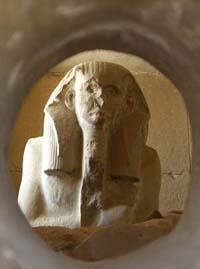
Djoser was a pharaoh of the 3rd Dynasty during the Old Kingdom. He built the Step Pyramid as part of his funeral complex at Saqqara. Djoser started it as a 200’ square stone mastaba (type of tomb) with sloped sides. When finished, the pyramid rose in six slanting steps to 200’. Later pharaohs considered Djoser’s reign to be the beginning of pharaonic history. Records state that the step pyramid’s design was the work of Djoser’s vizier, Imhotep.
Click here to discover more about Djoser
Snefru
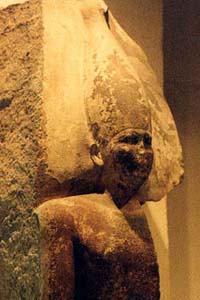
Snefru was a pharaoh of the 4th Dynasty in the time of the Old Kingdom. He built the first true pyramid and changed the orientation of the funerary complex to east-west. He built two pyramids in the funerary complex at Dahshur but his burial was in the Red Pyramid. Scholar’s call Snefru’s first pyramid the Bent Pyramid. Structural flaws made it necessary to change the angle of its sides.
Click here to discover more about Snefru
Khufu
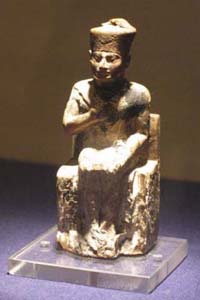
Khufu (aka Cheops) was a pharaoh of the 4th Dynasty, during the Old Kingdom, and he built the Great Pyramid. This pyramid is unusual for its large size and because it’s burial chamber is in the center of the pyramid rather than at the bottom. Scholars believed that the king changed the location of the burial chamber during construction. New information indicates that Khufu intended the burial chamber to be at the center of the pyramid from the beginning.
His complex also includes three pyramids for his queens and a mastaba for his vizier. Egyptologists have found two dismantled ships beside the Great Pyramid and they restored one of them.
Khufu only ruled for twenty-three years, so the Great Pyramid’s completion took less than twenty-five years. Later pharaohs called him a despot but records at the time say that he was a good pharaoh and his rule was a time of prosperity.
Click here to discover more about Khufu
Khafre
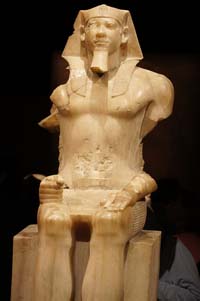
Khafre (aka Khafra) was a pharaoh of the 4th Dynasty, in the time of the Old Kingdom, and he built the second largest pyramid at Giza. The Great Pyramid and Khafre’s pyramid appear to be the same size because Khafre built his pyramid on a higher elevation. He also built a funerary complex that included the Great Sphinx near the causeway leading up to his pyramid. Contrary to some stories, slaves did not build the Giza pyramids, the citizens of Egypt did. The pharaohs organized a tax system that allowed them to keep a workforce building the pyramids.
Neferefre
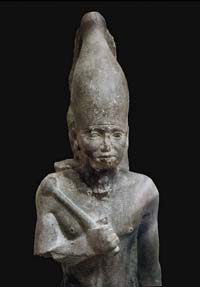
Neferefre, also called Raneferef, was a pharaoh of the 5th Dynasty during the Old Kingdom. He must have had a short reign because his pyramid only reached its lowest courses. Records state that Neferefre built a sun-temple but Egyptologists do not know its location. Excavators discovered a store of papyri in his pyramid temple. These provided information about the economic, administrative, and religious practices during the 5th Dynasty.
Click here to discover more about Neferefre
Pepi II
Pepi II was a pharaoh from the 6th Dynasty, during the Old Kingdom, and his rule was Egypt’s longest, 94 years. The first half of his reign seems to have been prosperous with trade existing with various places. During the later part of his reign, local officials grew in power and began setting up little kingdoms. The second half of Pepi II’s reign was a time of economic crisis. Circumstances forced him to establish an economic overseer in Upper Egypt.
Nitocris
Nitocris was the last pharaoh of the 6th Dynasty, during the Old Kingdom, and a woman. Later historians claimed that she was the daughter of Pepi II and told various legends about her. According to one story, she built the smallest pyramid at Giza (built by Menkaura). Historians called her the most beautiful woman of her time and said she used water to kill her brother’s murders. Modern scholars doubt that Nitocris ever existed.
Senusret I
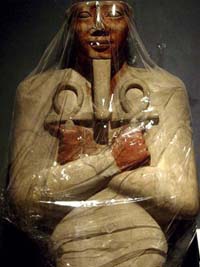
Senusret I was a pharaoh from the 12th Dynasty in the Middle Kingdom. His reign was a time of peace with no records of military campaigns found to date. Senusret I was the first pharaoh to begin irrigating the Faiyum to open more land for cultivation purposes. His statues show signs of his actual appearance which marks a new idea in the depiction of pharaohs. Senusret built a pyramid and a funerary complex at Lahun.
Click here to discover more about Senusret I
Ahmose I
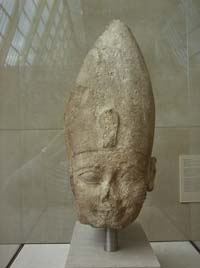
Ahmose I was the founder of the 18th Dynasty which began the New Kingdom. He began the reunification of Egypt after the Second Intermediate Period. He fought battles throughout Egypt, Palestine and Kush as he sought to banish the Hyksos. Goods and artwork from this period show a Minoan influence in the design on Egyptian forms. Ahmose I began building projects at Memphis and in his religious capital Thebes, especially at Karnak. His tomb location is unknown but his mummy was part of the Deir el-Bahri royal mummy stash.
Amenhotep I
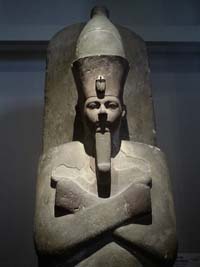
Amenhotep I was from the 18th Dynasty, during the New Kingdom. He was the son of Ahmose I and he continued his father’s building projects and his military campaigns. Amenhotep I military campaigns brought in booty that allowed the pharaoh to fund his building projects. The workmen at Deir el-Medina worshiped him, and his mother, as their patron gods for centuries. Deir el-Medina was the town where the government workers who built the tombs in the Valley of the Kings lived. During this period, it became a rule that royal females could only marry a king.
Thutmose II
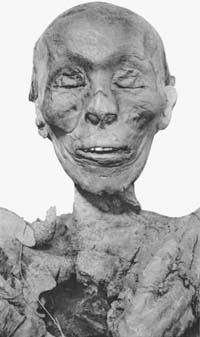
Thutmose II was part of the 18th Dynasty, in the New Kingdom. The son of Thutmose I and the father of the better known Thutmose III, he was only able to rule between 3 and 13 years, a period disputed by scholars. His wife, queen Hatshepsut, attempted to replace his name on monuments with hers. Thutmose III, later, tried to restore his father's name and this resulted in conflicting information about Thutmose II's life. His mummy, found in the royal cache at the Temple of Hatshepsut, shows signs of weakness and diseases that caused his death.
Click here to discover more about Thutmose II
Hatshepsut
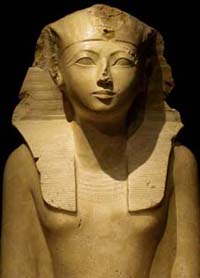
Hatshepsut was a pharaoh from the 18th Dynasty, during the New Kingdom, and a woman. When her husband (Thutmose II) died, his heir (Thutmose III) was a young child. Hatshepsut began her rule as his regent but she became the pharaoh. She claimed to be the child of Amun and transformed herself into a king by wearing the symbols of kingship.
Hatshepsut emphasized her right to rule through her bloodline. She ruled for almost twenty years and built all over Egypt. Hatshepsut’s mortuary temple at Deir el-Bahri and her tomb in the Valley of the Kings are well-built and beautiful. She also sent trade missions to Punt that brought back various exotic goods.
Click here to discover more about Hatshepsut
Thutmose III
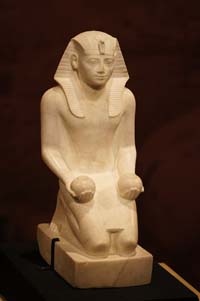
Thutmose III was from the 18th Dynasty, during the New Kingdom, and he ruled alone for thirty-two years. He conducted military campaigns in the Levant and conquered most of Palestine. Hatshepsut’s name and monuments were not dishonored until the end of Thutmose III’s reign. He built many monuments and collected a vast amount of booty from his military campaigns.
Click here to discover more about Thutmose III
Amenhotep II
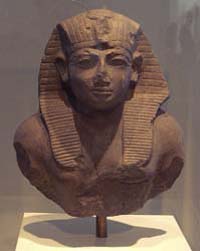
Amenhotep II was an 18th Dynasty pharaoh, during the New Kingdom, and co-regent with his father, Thutmose III. He completed the dishonoring of Hatshepsut’s monuments to end any claims by her family for the right to rule. Amenhotep II ruled for almost thirty years and his depictions show him as an athletic man. He built various temples including one to worship Horemakhet, a god associated with the Great Sphinx.
Amenhotep III
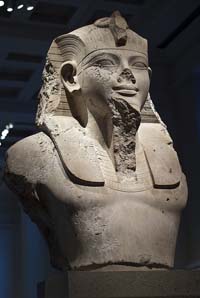
Amenhotep III ruled during the 18th Dynasty of the New Kingdom for thirty-eight years. Later records said that harvests during his time were rich and he became a fertility god. Amenhotep III might have been a child when his reign began and he was the son of Thutmose IV. He called his palace “the gleaming Aten” and emphasized the worship of the various solar deities. Amenhotep III built a large tomb in the Valley of the Kings and the Colossi of Memnon near his mortuary temple.
Click here to discover more about Amenhotep III
Amenhotep IV/Akhenaten
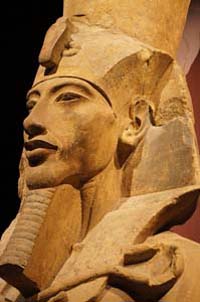
Amenhotep IV (who later took the name Akhenaten), was an 18th Dynasty pharaoh during the New Kingdom. Many scholars believe that his reign did not overlap with that of his father because he might have had an older brother. He ruled for less than twenty years but his reign had a great impact. Akhenaten, also spelled Echnaton, came to the throne at a time when the priests of Amun were wealthy and powerful. He built a temple to Aten at Karnak during the first few years of his reign.
In the fifth year of his reign, Akhenaten built a new capital at Amarna called Akhetaten. He changed his name and declared Aten the only god in Egypt.
The military supported this move at the beginning of his reign but many people still worshiped the old gods in private. His wife was an important part of his religious rituals and depictions of her making sacrifices exist at Amarna.
Click here to discover more about Akhenaten
Neferneferuaten
Neferneferuaten was a female pharaoh from the 18th Dynasty of the New Kingdom. Scholars believe that she ruled as a co-regent with Akhenaten and some believe she might have ruled in her own right after his death. Scholars differ about her identity though they agree on two candidates. Many scholars believe Neferneferuaten was Akhenaten’s queen, Nefertiti. Some scholars believe she was Meritaten, the oldest daughter of Akhenaten and Nefertiti.
Tutankhamun
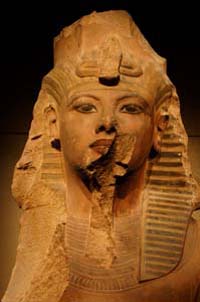
Tutankhamun was a pharaoh from the 18th Dynasty, during the New Kingdom, and he is the best known pharaoh today. He was the son of Akhenaten and became pharaoh at the age of nine. During the first year of his reign, Tutankhamun abandoned Amarna and restored the cults of the old gods. His regent was Horemheb who was a senior military official.
Tutankhamun restored the power of Thebes and died after around ten years of rule. Later scribes excluded his name from many of the kings’ lists and people forgot his rule. For this reason, tomb-robbers never found his tomb in the Valley of the Kings. Egyptologists found his treasures and his body intact when they excavated his tomb in the 1920s.
Click here to discover more about Tutankhamun
Ramses I
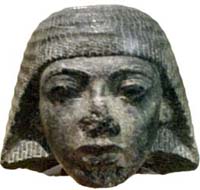
Ramses I was part of the 19th Dynasty, during the New Kingdom, and later historians claimed that he founded this dynasty. Ramses I and his heirs considered Horemheb the founder of their dynasty. Ramses I was not Horemheb’s son but he was his appointed heir. Ramses I was an older man when he became pharaoh because his son’s birth took place before his ascension. He ruled for less than a year and set his son up as his heir immediately after gaining the throne.
Click here to discover more about Ramses I
Seti I
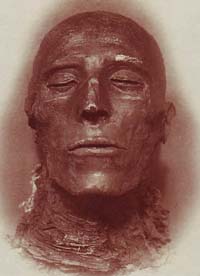
Seti I was the son of Ramses I, part of the 19th Dynasty, and a ruler during the New Kingdom. He restored the traditional temples and opened old mines. To raise money for his building projects, Seti I conducted military campaigns. The exact length of his reign is not known but the highest year found in the archaeological record is eleven.
Click here to discover more about Seti I
Ramses II
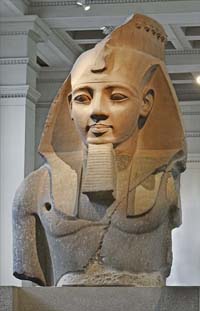
Ramses II was the greatest pharaoh of the 19th Dynasty, during the New Kingdom, and one of the most powerful pharaohs. He had a period of co-regency with his father, Seti I, and went on various military campaigns. Ramses II’s depictions often include his various children (he had at least 95) to show his dynasty.
He reigned for sixty-seven years and built a massive tomb for his children in the Valley of the Kings. Ramses II usurped monuments made by older pharaohs by erasing their names and carving his own instead. He declared himself a god before the tenth year of his reign and outlived his twelve oldest sons.
Click here to discover more about Ramses II
Merenptah
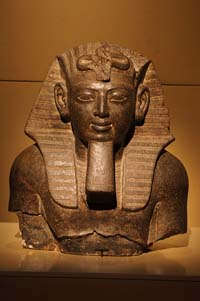
Merenptah was the thirteenth son of Ramses II and ruled during the 19th Dynasty of the New Kingdom. He conducted campaigns in Palestine and his stele contains the first written mention of Israel. After he defeated a Libyan invasion, he had a peaceful reign and built temples. Merneptah must have been older when his rule began because it lasted for only nine years.
Twosret
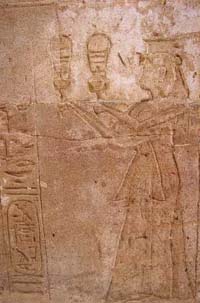
Twosret was a female pharaoh and the last ruler of the 19th Dynasty of the New Kingdom. She might have been Merneptah’s daughter and she was the wife of his son, Seti II. Seti II’s heir was a young boy who had an atrophied leg due to polio. Twosret served as Saptah’s regent and she reigned as pharaoh for at least two years after his death. Twosret was the third female pharaoh to rule during the New Kingdom.
Ramses III
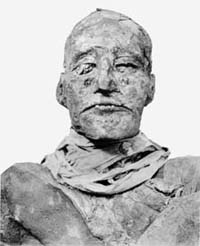
Ramses III was from the 20th Dynasty of the New Kingdom and records show that he was not a relative of the previous Ramses. After Twosret’s death, there was a period of lawlessness that Sethnakht, Ramses III’s father, ended. Ramses III had to fight various invaders trying to take advantage of Egypt’s internal turmoil. He built a mortuary temple in the Theban Necropolis and various other buildings.
He reorganized the temple administrations and land allocations. By the end of Ramses III’s thirty-one year reign, one-third of the farm land belonged to the temples.
This caused food shortages and led to one of the first recorded strikes of the workers at Deir el-Medina. It also led to a weakening in the power of the pharaoh and the central government.
Click here to discover more about Ramses III
Xerxes I
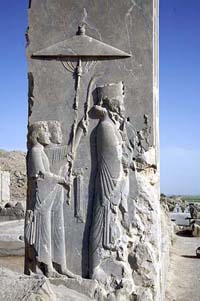
Xerxes I ruled Egypt as part of the first Persian Dynasty, the 27th Dynasty, in the Late Period. The Egyptians did not like him because he ignored the temple privilege. Like the other pharaoh’s from his dynasty, Xerxes I was an absentee pharaoh who ruled from the region that is modern Iran. He forced Egypt to provide ships and equipment for his invasion of Greece but his fiscal tributes were not oppressive.
Click here to discover more about Xerxes I
Cleopatra VII
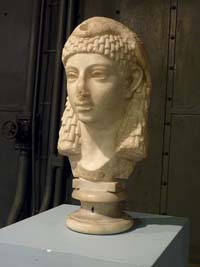
Cleopatra VII was the last pharaoh of the Ptolemaic Dynasty (Ptolemaic Period). She ruled alongside her brother/husbands Ptolemy XIII and Ptolemy XIV and her young son Ptolemy XV. Rome was moving to invade Egypt but Mark Antony, Cleopatra’s lover, helped her stand against Rome. He provided her the means to keep control of Asia Minor and Palestine. Augustus invaded Egypt and killed Mark Antony. Cleopatra committed suicide which marked the end of Pharaonic Egypt.
Click here to discover more about Cleopatra
